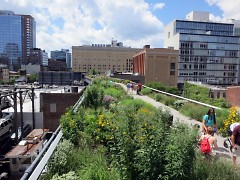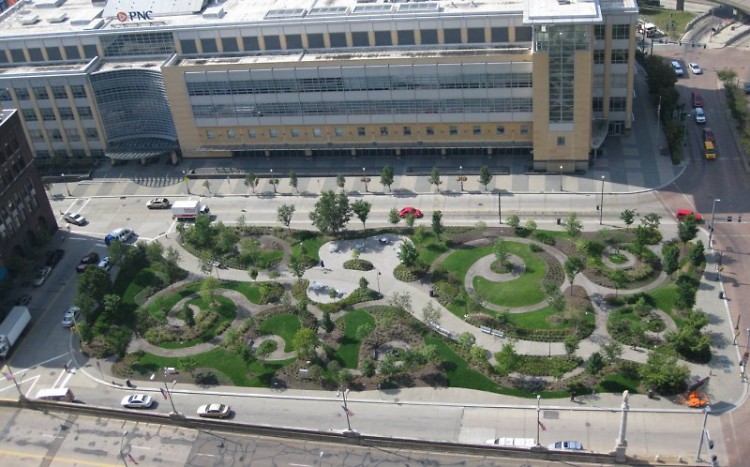In an era of urban revitalization that is creating increased populations in American urban environments, it is important for cities to maintain the appropriate levels and quality of green space to keep up with the growth. Various studies indicate many benefits that urban green space provides. Four major benefits of city parks are they increase health, social connection, aid the environment and have significant positive impacts on the local economy.
Health
It is important to keep personal health high and health care costs low. Michigan ranks fifth in rates of Obesity and 60% of adults are obese in Kent County. Urban green space plays a crucial role in the health of the community. Several studies have shown that parks have the ability to increase physical and mental health of those who live around and utilize them. This is especially true concerning children and the senior population. A 2003 study featured in the Journal of Epidemiology and Community Health showed that the percentage of green space inside a .6 mile radius and a 1.86 mile radius had a significant relation to overall general health. The study shows that this correlation seems to be especially high when concerning lower socioeconomic groups, elderly and the youth. A 2004 study at Deakin University showed that green space is crucial for the physical and mental growth of children and that participation of minors in physical activities is dependent on the close proximity and accessibility of urban green space.
Many professional journals have featured articles over the years about the psychological effects urban green spaces have on individuals. A 1984 article in Science Magazine featured a study conducted in a Pennsylvania hospital that showed patients with a window view of a local city park had a considerably higher rate of recuperation than those with a view of the back of a building. The Journal of Environmental Psychology featured an article about a study that showed having quality urban greens spaces, or “restorative environments” in the author’s words, to view often is crucial for those living in urban environments. The article argues that people need to restore their psychological resources in environments that are not fully conducive to their activities. These psychological benefits could be explained by the work of Edward Wilson, famous American biologist. He coined the term in the 1980’s of Biophilia. His hypothesis suggests that humans cannot be separated from nature and that being connected to nature is the quintessence for psychological well-being.
Social Connection
Neighborhoods thrive where there exists a strong sense of community between residents. Studies have shown that parks can cause a significant rise in social connection in communities they are located in. A 2012 article in the journal of Management of Environmental Quality explains how parks can aid in increased social interactions in cities. High density development separates residents, resulting in social disengagement. The crowded urban environment makes it difficult to interact with residents and inhibits productive social communications. Parks offer a space for social gatherings on top of increasing a sense of communities. An article in the journal of Environment and Behavior discussed a study that showed that seniors living in the inner-city who have accessibility to green space communities have significantly higher social ties with their neighborhoods than those with less access.
Environment and Economy
Humans are having an impact on their environment and it is important that cities implement best practices in sustainability. These environmental factors also play an economic role in the city. Several studies show the crucial roles parks play in helping the environment. An article in the July 2011 issue of the Journal of Environmental Protection illustrates some of the many advantages of urban green space. Ecologically urban green spaces supply cities with ecosystems services such as preservation of biodiversity and regulation of the urban climate. This is because many surfaces in the urban area absorb heat, which studies have shown can increase temperatures in a city by five degrees. Urban green spaces help with air and noise pollution control. Research shows that 85% of air pollution in a park can be filtered because air pollutant particles are trapped by vegetation. Noise pollution can be reduced by green space depending on their quantity and distance from the cause of the noise pollution. According to the Trust for Public Land located in Atlanta, the city receives $15 million annually in air pollution reduction from trees. Just like Atlanta, Grand Rapids also benefits financially and environmentally from its urban forestry. Studies show that Grand Rapids benefits from the removal of harmful environmental pollutants. Some of the numbers include $2.21 million annual from the removal of 283 tons of pollutants. $5.15 million from 280,000 tons of carbon storage.
During a fragile time of financial recovery, a major concern for Grand Rapids is its economic viability. With a handful of Michigan cities under the control of an emergency financial manager and Detroit filing for the largest municipal bankruptcy in history, we want to take every economic step possible to ensure our city has a thriving future. It is exciting to see Forbes list us as number one in “Cities to raise a family” and in the top 15 for “Cities with emerging downtowns.” To maintain our increasing dominance as Midwest City we cannot let our parks crumble in our neighborhoods. Parks play an important role in increasing property values, property marketability and aids in talent retention.
A study completed in 2005 for the Illinois Association of Park Districts found parks provide a positive benefit for real estate values depending on how far the home is from the park. Neighborhood parks can provide up to a 20% increase in housing values for those homes facing the park. Community parks may also provide benefits up to 33% of the residential real estate value. It was found that homes within 1,000 feet of a large community park may receive a 9% increase in home value. Homes in close proximity to greenbelts generate a premium of 11% in value over the average price.
Grand Rapids needs to practice better talent retention to avoid losing their educated and skilled workers to cities offering better opportunities. Currently it appears that the strength of the future economy of post-industrial cities will be based on how many millennials a city can attract. A millennial is the generation born between the early '80s and 2000s with an estimated population of 80 million living in the U.S. An article in the November 2012 issue of Governing magazine explains that millennials will be the generation that will push the housing market and innovation economy for at least two. The generation’s movement patterns reflect that one of their largest concerns is quality of life. They are attracted to cities that have thriving neighborhoods, support multiple modes of transportation and exercise smart land use. The article explains how the majority of individuals settle down by the age of 35 and the millennials are fast approaching that time in the next few years. Our second-tier city will have limited opportunities in the next ten years to move urban projects forward that make our city attractive to this generation. Kaid Benfield, author of several books on smart growth and sprawl, explains it best when he says that “20th Century land use will not help a city attract 21st century residents.” Smart land use, such as parks, is one way to increase the attractiveness of our city. We do not want individuals, looking to settle down with a family and a career, to choose another city over ours.
The Rapidian, a program of the 501(c)3 nonprofit Community Media Center, relies on the community’s support to help cover the cost of training reporters and publishing content.
We need your help.
If each of our readers and content creators who values this community platform help support its creation and maintenance, The Rapidian can continue to educate and facilitate a conversation around issues for years to come.
Please support The Rapidian and make a contribution today.


